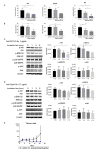CD147-Cyclophilin a Interactions Promote Proliferation and Survival of Cutaneous T-Cell Lymphoma
- PMID: 34360654
- PMCID: PMC8346093
- DOI: 10.3390/ijms22157889
CD147-Cyclophilin a Interactions Promote Proliferation and Survival of Cutaneous T-Cell Lymphoma
Abstract
CD147, a transmembrane glycoprotein that belongs to the immunoglobulin superfamily, and cyclophilin A (CypA), one of the binding partners of CD147, are overexpressed in tumor cells and associated with the progression of several malignancies, including both solid and hematological malignancies. However, CD147 and CypA involvement in cutaneous T-cell lymphoma (CTCL) has not been reported. In this study, we examined CD147 and CypA expression and function using clinical samples of mycosis fungoides (MF) and Sézary syndrome (SS) and CTCL cell lines. CD147 and CypA were overexpressed by tumor cells of MF/SS, and CypA was also expressed by epidermal keratinocytes in MF/SS lesional skin. Serum CypA levels were increased and correlated with disease severity markers in MF/SS patients. Anti-CD147 antibody and/or anti-CypA antibody suppressed the proliferation of CTCL cell lines, both in vitro and in vivo, via downregulation of phosphorylated extracellular-regulated kinase 1/2 and Akt. These results suggest that CD147-CypA interactions can contribute to the proliferation of MF/SS tumor cells in both a autocrine and paracrine manner, and that the disruption of CD147-CypA interactions could be a new therapeutic strategy for the treatment of MF/SS.
Keywords: CD147; Sézary syndrome; cutaneous T-cell lymphoma; cyclophilin A; mycosis fungoides.
Conflict of interest statement
The authors state no conflict of interest.
Figures





References
-
- Scarisbrick J.J., Prince H.M., Vermeer M.H., Quaglino P., Horwitz S., Porcu P., Stadler R., Wood G.S., Beylot-Barry M., Pham-Ledard A., et al. Cutaneous Lymphoma International Consortium Study of Outcome in Advanced Stages of Mycosis Fungoides and Sézary Syndrome: Effect of Specific Prognostic Markers on Survival and Development of a Prognostic Model. J. Clin. Oncol. 2015;33:3766–3773. doi: 10.1200/JCO.2015.61.7142. - DOI - PMC - PubMed
MeSH terms
Substances
Grants and funding
LinkOut - more resources
Full Text Sources
Medical
Miscellaneous

